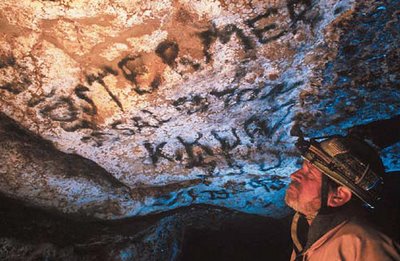
[Image: Caver Chris Nicola looks at markings left in Priest's Grotto; National Geographic Adventure/Peter Lane Taylor].
"In the spring of 1944," we read, "a group of 38 Ukrainian Jews emerged weak and jaundiced from a cave they'd used for nearly a year to escape the horrors of the Holocaust."
Caver Chris Nicola rediscovered this story 13 years ago, after exploring Ukraine's Gypsum Giant cave systems. "While there, during an expedition into the tenth longest cave in the world, his team came across two partially intact stone walls and other signs of habitation." Learning about the Jewish families who had used these caves for survival, "Nicola grew determined to learn how people with no prior caving experience or specialized equipment were able to live in such a hostile environment for so long."
So Nicola returned with a photographer, Peter Lane Taylor, and he learned more of the story.
The Holocaust refugees' "first stop was Verteba, a well-known tourist cave where the families spent their first six months. There, the Jews struggled to find enough water and suffered from the toxic buildup of smoke from their cooking fire. Then on May 5, 1943, after narrowly avoiding capture at the hands of the Gestapo, the families relocated to a previously unexplored cave located beneath land owned by a local parish priest. It was called Popowa Yama, or Priest's Grotto, and it would be the Jews' refuge from the Holocaust for the next 344 days."
They lived without sun for more than a year.
"At the surface, Priest's Grotto is little more than a weedy hole in the ground amid the endless wheat fields stretching across western Ukraine. A short distance away, a low stand of hardwoods withers in the heat and is the only sign of cover for miles around." Here, "there's nothing to indicate that one of the longest horizontal labyrinths in the world lies just underfoot."
The story is almost unbelievable. For instance, "one of the survivors, only four years old at the time, said she remembers playing with a bright, shining crystal in the cave. One of the largest crystals in the world is close to their campsite inside Priest's Grotto, and chunks of it will sometimes fall to the ground. When we saw the crystal, we realized that that was where she used to play."
Or: "They had few candles, so light was limited to three short periods each day. After enough time spent wandering in the dark, they memorized the feel of the cave floor on their bare feet. It was like directions in braille."
The inside of the earth, lined with language.
[Thanks, Neddal!]
No comments:
Post a Comment